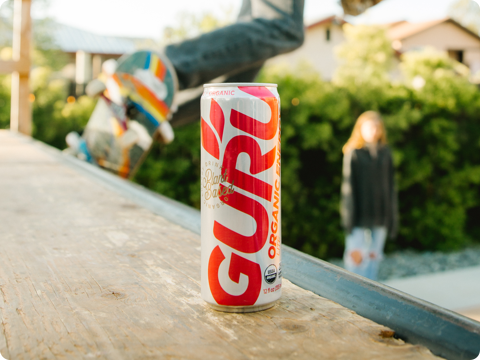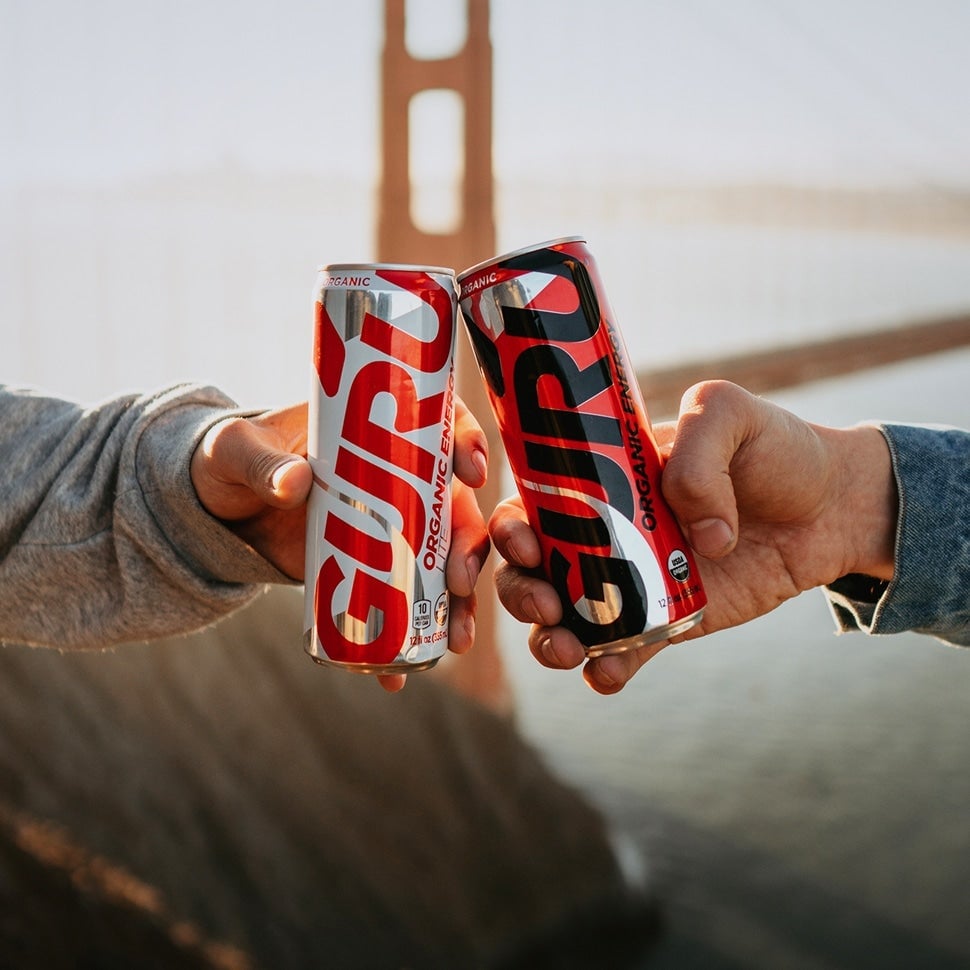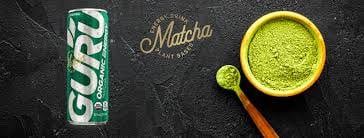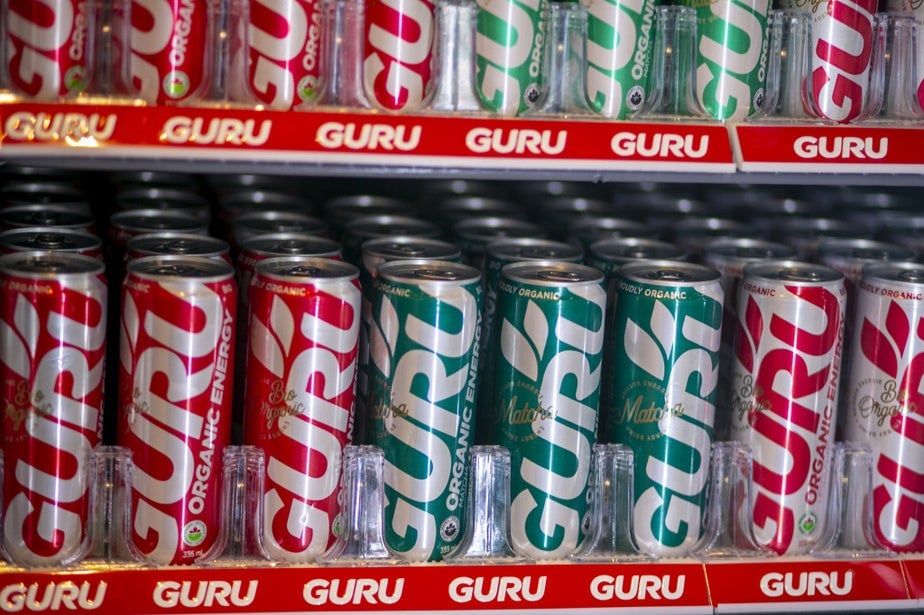Guru Energy Drink Disrupts Market with Plant-Based Energy

In an ideal world, people will wake up filled with lots of energy and motivation to get through the day. In reality, most are sleep-deprived.
In a 2019 survey, the average hours of sleep Americans got around this period was only five hours and thirty minutes, almost an hour less than how they fared in the previous year. Many are overworked, tired, and are barely managing themselves daily.
It isn’t surprising then that one of the most popular drinks for years is coffee. For a lot, though, a cup may not be enough, especially if they’re looking for that jolt that can kick away the sleepiness and energize their bodies. This is where energy drinks come in.
The future of the energy drinks market is bright. A forecast by Allied Market Research revealed that the industry market size already reached over $53 billion in 2018. From this point until 2026, it could achieve a compound annual growth rate (CAGR) of 7 percent or a market value of $86 billion.
But while the market is still dominated by staples like Monster Energy Drink and Red Bull, new players are entering the alternative energy drink field. One of these is Guru Organic Energy Drink.
What Is Guru Energy Drink?
Guru is an energy drink, particularly sparkling water, that aims to separate itself from the standard offers in the market, ultimately revolutionizing the concept of the “energy drink” people have over the years.
The brand, which started and has headquarters in Canada, boasts of a caffeine-laced drink that’s purely organic or plant-based. In other words, it is positioned as a far healthier alternative.
Although the name may not immediately ring a bell, Guru has been around for over 20 years. It began around the same time that “smart drinks” took off the shelves. Smart drinks refer to beverages with nootropic components that include vitamins, minerals, and herbs. As nootropics, they’re believed to enhance cognitive function, so the person feels more alert and focused despite exhaustion or lack of sleep.

The Guru founder at the time opened a SONA nightclub while the art director of the company, Justin, blended one of the first plant-based smart drinks. From the various experimentations and changes in formulations, the small team eventually launched the first Guru cans in 1999, about three years after the release of Justin’s smart drinks. Back then, their market was their friends who probably loved to party after a day of work.
The rest is history. Since then, the can has undergone at least two label revisions to also highlight the positive changes they have implemented in their formulations and even in their lifestyle. Around this time, the guys had mellowed and spent more time outdoors with nature.
Most of the formulations were the brainchild of Luc Martin-Privat, whom they called the brewmaster. He is the most suited to do the job, considering that he completed pharmacology.
Organic Energy Drink Options
Today, the drinks are available mostly online through Amazon and eBay. However, for those who wish to shop for other healthy alternatives, they can visit websites like the Buffalo Market, a purpose-driven e-commerce platform. The brand is getting traction in North America as well.
Buyers can choose from any of its four flavors, which are usually available in 8 and 12 ounces:
- Guru Organic Energy (Yerba Mate)
- Guru Organic Energy Lite
- Guru Organic Energy Original
- Guru Organic Energy Matcha
What does GURU Energy taste like?
The best way I can describe Original Flavored Guru is natural Redbull but slightly tangy or lemony and some mild grape flavor. The carbonation is heavy for an energy drink and feels lighter than most. The tartness is present from the
The Energy Matcha tastes like soda water with a green tea aftertaste, but sweeter and makes your tongue tingle. Definitely does not feel like soda pop
The Guru website comes with a nifty tool to help consumers compare the various choices. Take, for example, the Lite and Original versions. Both have the same amount of natural caffeine in grams, and they also use the same sources. However, they significantly differ in terms of calories. Lite packs only 25 calories, while the Original contains 115 calories.
The company sells cans in packs of 24, which are a lot and can last for about a month for those who don’t need to depend on energy drinks every day. Some reports, though, suggest that one can also find packs of four. These are excellent for those who wish to try Guru but don’t want to spend a lot of money on it in the beginning. So how does Guru taste? We think they come in several delish flavors and certainly taste more natural than conventional energy drinks full of chemical aftertastes.

Are GURU energy drinks healthy?
Dissecting the Ingredients
For a brand that’s brave enough to say that they are plant-based and organic, it is only right that one learns to digest what each can contains. This is the part where consumers can learn the primary ingredients of Guru.
1. Sources of Caffeine
A can of Guru can contain a number of herbs known to improve levels of energy, focus, and cognition, as well as other potential health benefits:
Green Tea
Many teas can be excellent alternatives to regular coffee. They often contain enough caffeine to boost one’s energy level without the crash. One of these is green tea. Among the various teas with traces of caffeine, green tea can contain about 35 mg of caffeine per cup. Regular coffee has at least 100 mg of caffeine. This makes green tea “gentler” than black tea, which provides up to 80 mg of caffeine per serving.
Green tea also has antioxidants, which can help ward off chronic diseases. In 2021, a study revealed that this substance could increase p53 levels. P53 is a naturally occurring anti-cancer protein which can get rid of cancerous cells and restore or repair damaged ones.
Matcha
A popular rival of green tea is matcha, a type of tea that originated in Japan. Matcha, which is often sold as a powder, contains more caffeine than green tea. This makes it the next best option for those who want to kick their coffee addiction gradually.
Matcha also packs more calories than green tea. But the differences are small and compared to sodas, both teas definitely have way lower calories.
Like green tea, this Japanese tea also provides plenty of health benefits. In a 2019 research by Kumamoto University, they found out that matcha could help reduce anxiety. Matcha helps regulate dopamine and serotonin, two potent mood receptors.
Dopamine helps create feelings of pleasure while also enhancing focus and memory. Higher levels of serotonin, on the other hand, are associated with fewer symptoms of depression.
Guarana
Guarana is a climbing plant that is native to Brazil, particularly the Amazon basin. They are popular for their seeds, which can grow the same size as coffee beans.
This plant, which is usually manufactured into powder or extract, is becoming one of the most popular ingredients for energy drinks because of its incredibly high caffeine content. It contains four times more caffeine than a regular coffee. While both can block a substance called adenosine, which triggers the relaxation of the brain, guarana sounds to be more effective than coffee in doing that.
But that’s not all. Guarana is also prized for how it seems to improve health and well-being
- First, it may help someone combat mental fatigue, including those who experience it as a side effect of their cancer treatments.
- Second, its antioxidant profile is similar to green tea.
- Third, like coffee, it can help speed up metabolism by 11 percent in twelve hours. It also encourages the body to burn calories even when it’s at rest.
Panax Ginseng
Panax ginseng is a root plant commonly cultivated in Korea, some parts of China, and Siberia. There’s not enough evidence to show that this contains caffeine. However, energy drinks like Guru include it because some studies show that it could improve brain function, particularly cognition and focus.
It may also have some anti-inflammatory properties because of its primary components, like ginsenoside. This one could decrease oxidative stress, which occurs when levels of cellular oxidation increase significantly. When left unmanaged, this stress could lead to cellular damage and, in turn, the development of chronic diseases.
Yerba Mate
Yerba mate is a popular tea from a plant that’s native to South America, although it also spread to the Middle East, such as Syria, when Argentina immigrants decided to settle there. One of the ways to consume it is by steeping the leaves in hot water, although today, one can also find it as a powder or an extract.
Like other substances on the list, yerba mate also contains caffeine. It is about 80 milligrams per cup, which means it could be just as energizing as black tea, but it won’t have the same crashing effect as caffeine. People who drink it are also less likely to experience symptoms such as feelings of anxiety.
It also has almost similar health benefits as green and matcha tea. In particular, a 2011 research cited how compounds of the mate tea may induce the death of colon cancer cells.
Meanwhile, a 2007 study by the University of Illinois Urbana-Champaign revealed an association between lower risks of bad cholesterol and drinking tea. It seems that mate tea activates an enzyme that helps increase good cholesterol.
Echinacea
Echinacea is an herbaceous flowering plant that belongs to the daisy family. It can grow up to four feet tall and can be found only in certain parts of America since they need some level of moisture.
Unlike yerba mate, green tea, and matcha, echinacea doesn’t contain any caffeine, but it still plays a vital role in an energy drink like Guru. This plant helps decrease the breakdown of caffeine, which allows the substance to stay in the body for a much longer period. It could mean that a can of Guru may be enough to sustain someone throughout the day.
Echinacea is also a renowned ingredient for many herbal or natural cold remedies. A 2007 study by the University of Connecticut, for instance, said that using this plant could decrease the odds of catching a cold by 50 percent. It may also reduce the duration of the illness by almost two days.
Taurine
None of the Guru drinks contain taurine, which is a well-known component of other energy drinks (the most notable is Red Bull). There could be many reasons for this, including the following:
- Taurine is a naturally occurring free-form amino acid, which means the body can produce it. There's no need to add more through energy drinks.
- This substance is now often produced synthetically. Guru aims to use only plant-based organic ingredients in their drinks.
- Taurine is, interestingly, banned in many European countries. It took 12 years for France to remove the ban because the benefits are unclear.
2. Sugar
Although Guru is sparkling water, it doesn’t taste like it. Instead, it has hints of sweetness because it contains sugar — a lot of it. A can will probably have 21 grams of sugar, which is also the primary source of carbs. But where does the sugar come from?
The company mentioned that the drink’s sugar content is between 20 and 35 percent lower than other energy drinks on the market. On average, a typical competitor drink of this kind would contain as much as 29 grams of sugar.
How much caffeine is in Guru Energy Drinks?
Our 8 oz organic energy drinks contain 100mg of naturally occurring caffeine, while 12 oz cans contain 140mg. A serving may include 80 mg of caffeine in the Matcha flavor. GURU Energy Drink contains 11.67 mg of caffeine per fl oz (39.45 mg per 100 ml). A 12 fl oz can has a total of 140 mg of caffeine.
Guru Drinks: The Key Benefits
With these data in mind, it’s safe to ask, “What are the benefits of consuming Guru Energy Drink?”
Four Good Things about Guru
Here are the best reasons to consume Guru beverages:
- It Seems to Have Healthier Ingredients than Other Energy Drinks
If one will take the company’s word as is, then definitely, Guru produces some of the safest drinks on the planet. Not of them are synthetic like taurine. Instead, they are both plant-based and organic, so they are more likely to be compatible with the body’s biochemistry. The risks of developing adverse side effects decline.
The ingredients used have been subjects of many studies, which also showed that they might have other benefits besides providing energy, focus, and better cognitive performance. For example, echinacea is a popular natural remedy against colds. The various teas provide anti-inflammatory and antioxidant properties.
- Each Can Contains Less Sugar
Even if it’s sparkling water, it still needs a bit of sweetness, perhaps to make it more relatable to consumers. After all, energy drinks are known for having this taste. However, according to Guru, the amount of sugar it contains remains much lower than that of its competitors.
Moreover, Guru said that the primary sources of sweetness are monk fruit and stevia. Not only are they also plant-based, but they also don’t have any calories. Stevia can also be as much as 200 times sweeter than sugar, thanks to its unique crystal structure that includes a scaffolding supporting three special sugars, according to a study by Washington University of St. Louis.
Despite its sweetness, stevia may actually help in regulating blood sugar levels. It contains an active component called TRPM5. This one stimulates one’s perception of taste, which can reduce the feeling of a bitter aftertaste, and, most of all, see to it that the pancreas produces enough insulin, particularly after every meal.
Insulin is a hormone that acts as a messenger or delivery guy for blood sugar or glucose to cells, which then use it to create energy. Abnormal levels of insulin, which one may determine through certain blood tests, may indicate that the pancreas isn’t working as effectively as before or that the cells are already less receptive to the hormone. Interestingly, one of the known culprits is the regular intake of conventional sugar.
When this happens, the person may already be suffering from insulin resistance. Many studies have already shown that these changes in the metabolic condition alone can increase the risks of chronic diseases ranging from diabetes to heart disorders.
Even the other types of sugar used, such as cane sugar, are organic. The cans don’t contain artificial sugars, like aspartame, which have been linked to different health problems.
Overall, the Guru Energy drink could be a better option for people who are following a low-carb lifestyle, those who want to lose weight, and individuals diagnosed with either insulin resistance or prediabetes. This drink may also be for people with type 2 diabetes, but they may need to consult their doctor first. At the very least, they can try the lite version, which has low calories.
- Consumers Can Pick among the Various Options
Sparkling water can be healthy, but it can also be boring, so it’s nice to play around and try the various flavors of Guru. Many consumers may also appreciate the fact that the brand tries to provide more distinct flavors than the ones commonly seen in the market. This could probably explain why they’ve decided not to offer fruity Gurus for now.
Besides the flavors, consumers can also choose between two sizes, which are 8 and 12 ounces. While the options for sizes are limited, they can help streamline the consumers’ decision-making process.
The eight-ounce cans, for example, are ideal for those who haven’t tried Guru before or want to know first how effective the product is before they buy more. They’re also great for road trips, overnight camping, and outdoor day activities, such as hiking or biking. They are easier to carry around.
The 12 ounces, on the other hand, are great for those looking for a nice pick-me-up but don’t want to keep on downing a lot of energy drinks in a day. Given the ingredients on the list, which are notable for their ability to improve cognitive performance and energy, one of this size per day is enough.
Lastly, Guru Energy Drinks are suitable for people who may be following a certain type of diet. They are vegan, vegetarian, and gluten-free. This is because they don’t contain unnatural ingredients.
- It Strives to Be Sustainable
Guru strives to be a brand with a purpose. From its stories, one can glean how branding veers away from being a party drink to a more ethical, sustainable option for energy drinks. The team also consciously used aluminum cans for packaging so they can still be reused and recycled.
These efforts are important in the United States because of the country’s growing land and water pollution issues. According to the Environmental Protection Agency (EPA), American households produce over 250 million tons of solid waste a year.
Many of these types of waste do not decompose quickly. In fact, it might take as long as 250 years for aluminum to rot—about three times longer than the average human lifespan. Moreover, they can accumulate in landfills. The more trash ends up in these places, the more the country has to convert empty spaces into these facilities when they can be used for something more productive like agricultural plots or solar farms.
On the other hand, when someone decides to recycle aluminum, many recycling facilities can already transform them into something usable within six weeks.
Where is GURU energy drink from?
GURU is distributed all over the world and originates from Canada, which has strict enforcement of quality and safety. Guru is certified USDA organic, non-GMO project verified, and vegan. It contains naturally-occurring caffeine due to the presence of guarana seed extract and green tea extract. The company is publicly traded, has been around for over 20 years and its mission is:
"GURU believes energy shouldn’t come at the expense of health. Which is why we are on a mission to clean up the energy drink industry, one can at a time."

===
Overall, Guru Energy Drink is the holy grail that consumers are looking for. It’s distinctively better than conventional brands for two reasons.
First, it strives to be a healthier version of energy drinks. That alone is a feat—something that’s hard to come by. Although it uses some sugar, the brand is able to lower the serving per can by using only organic ingredients and opting for plant-based options like monk fruit and stevia. Some studies already showed how these alternative sweeteners—stevia, in particular—could potentially help balance insulin levels.
Second, Guru is a sustainable brand, which aligns well with its branding and mission: go out, enjoy the outdoors, but love the environment more. By using aluminum and, most of all, encouraging its users to recycle the material, it already contributes to making the country safer, healthier, and more available for future generations.
===
Guru Energy Drink is distinctively better than conventional brands because it is healthier and practices sustainable methods.

